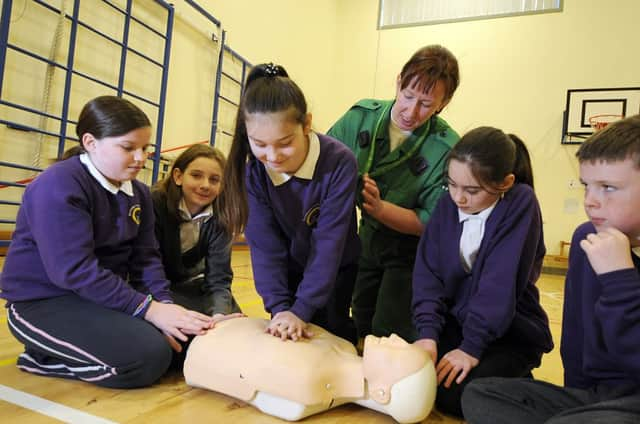Hands on lesson in saving lives


The number of people surviving a cardiac arrest outside of hospital is tragically low. Fewer than one in ten survives, partly because people around them don’t have the skills or confidence to recognise a cardiac arrest, call 999 immediately and perform cardiopulmonary resuscitation (CPR) until the ambulance arrives.
BHF Scotland is determined to improve this shocking statistic, by turning the Scottish people into a nation of lifesavers. It’s a bold but achievable ambition and could save hundreds of lives each year.
Advertisement
Hide AdAdvertisement
Hide AdWe’re starting by training senior school pupils with a new, simpler model of CPR training: Call Push Rescue, which teaches them, in under half an hour, how to help save a life. That’s all the time it takes for the training, and you don’t even need a trainer – our DVD explains everything so all you need is a group of willing people and some space to practise. The message is clear: if you witness someone having a cardiac arrest, call for help, push hard on the centre of their chest and perform rescue breaths.
If we train all the young before they leave school, we’ll create a nation of lifesavers with the skills and confidence to perform CPR, who will share those skills with their elders, peers and their own children in future. Indeed, the Call Push Rescue kit is designed to be taken home so the whole family can be trained – it’s that easy.
Contrary to what you might have seen on TV, a cardiac arrest and a heart attack are not the same. A heart attack is a sudden interruption to the blood supply to part of the heart muscle. It’s likely to cause chest pain and permanent damage to the heart. The heart still sends blood around the body, and the person remains conscious and breathing.
A cardiac arrest occurs when the heart suddenly stops pumping blood around the body. Someone having a cardiac arrest will suddenly lose consciousness and stop breathing, or stop breathing normally. Unless immediately given CPR, they will die within minutes.
A person having a heart attack is at high risk of a cardiac arrest. Both are life-threatening emergencies requiring immediate medical help.
I know people worry about not being sure if someone is having a cardiac arrest. Take a few seconds to look at their chest. Put your ear to their mouth. They won’t be breathing normally or won’t be breathing at all. Intermittent gasping is not normal breathing. If you’re not sure, the Scottish Ambulance Service is just a phone call away to help you assess the situation.
There’s another misconception that most out-of-hospital cardiac arrests happen in public places. But eight in ten happen at home, often in front of families and loved ones.
A BHF Scotland survey revealed that three quarters of the Scottish public wouldn’t feel confident performing CPR on a loved one. They feel they lack the knowledge and skills to act and they’d look to someone else to take charge. These are the obstacles that our nation of lifesavers initiative aims to overcome.
Advertisement
Hide AdAdvertisement
Hide AdWhen we launched the initiative on European Restart a Heart Day 2014, we put senior pupils from St Benedict’s High School in Linwood, Renfrewshire, through the Call Push Rescue training. Their enthusiasm and willingness to learn was impressive, and afterwards they said it felt good to know that they now had the skills that could save a life.
We’re very clear that these skills could save a life, because sadly CPR isn’t always successful. I’ve been asked about the emotional impact on someone of performing CPR on a loved one and it being unsuccessful. Of course it would be devastating to see someone you love die despite your best efforts to save them. But surely it’s better to give them a fighting chance of survival than to do nothing. Just think of the emotional impact of not being able to act at all?
Like St Benedict’s, most secondary schools now teach CPR, but there are still too many schools where this life-saving training isn’t available, and I urge them to get involved.
I want to see Scotland emulate the Norwegian example, where children learn CPR as part of the school curriculum. Norway’s survival rates from out-of-hospital cardiac arrest are one in four and, if we follow this example, we could save 5,000 lives a year in the UK; so hundreds in Scotland alone.
As a significant step towards this, I welcome the recent launch of the Scottish Government’s strategy on Out of Hospital Cardiac Arrest, with its commitment to improving outcomes and changing attitudes in our communities to help save more lives. Together, we can transform Scotland into a nation of lifesavers. To find out how, visit bhf.org.uk/lifesavers
• Catherine Kelly is director of prevention, survival & support, British Heart Foundation www.bhf.org.uk